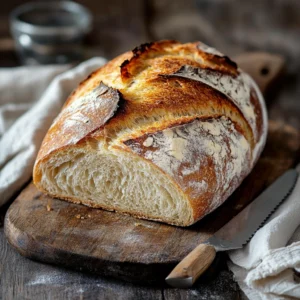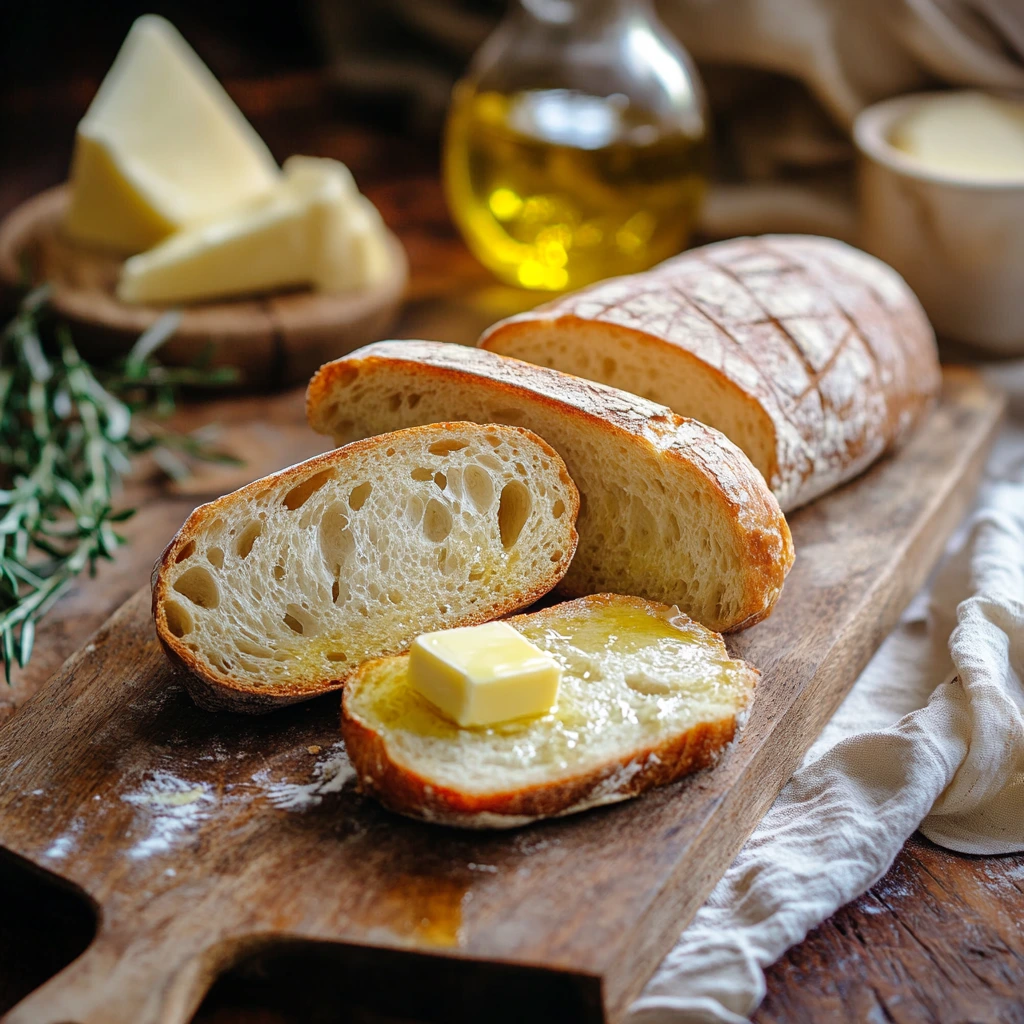Ever wanted to master a crusty, golden French bread recipe that smells like a Parisian bakery? This article will guide you through the why and how of perfecting French bread at home, starting with a cozy story, moving through essential techniques, and answering the most common questions. We’ll walk through texture secrets, flour tips, and why French bread just hits differently. Let’s begin where all good recipes start: with a story from my kitchen.

Table of Contents
The Story & Intro: My Cozy Start with French Bread Recipe
Why this French bread recipe brings back sweet memories
Years ago, on a rainy day in Asheville, I found myself with little more than flour, water, and curiosity. I’d seen my mom knead dough with a rhythm that looked like magic. That afternoon, craving something warm and a little adventurous, I tried making French bread from scratch. It wasn’t perfect, my oven smoked, and the crust nearly shattered—but the flavor? Unbelievable. It tasted like possibility.
French bread has this hypnotic quality: that crisp crust, tender interior, and rustic shape. You tear it, not slice it. It’s casual, welcoming, and soulful. The French bread recipe I’m sharing here isn’t about perfection; it’s about creating something authentic and deeply satisfying, even if your counters get a little messy.
The heart behind the crust
What makes a great French bread recipe? Simplicity. Water, flour, yeast, salt, and a little time. But the secret is how you treat those ingredients. That day, I learned patience as I waited for the dough to rise and joy when my neighbor asked, “Did you bake that?” Since then, I’ve baked it dozens of times, refining this recipe each go.
Craving that rustic charm again? This French bread recipe is the same one I return to. And if you’re curious about what goes into it, you’ll love diving into the core ingredients of French bread.

French Bread Recipe – 1 Stunning Loaf, Crisp & Chewy Perfection
Equipment
- Stand Mixer
- Baking Sheet
- Parchment Paper
Ingredients
Dough
- 2 1/4 cups warm water 112° to 115°F
- 2 tsp sugar
- 1 packet active dry yeast about 2 1/4 tsp
- 2 tsp sea salt
- 2 tsp unsalted butter softened
- 5 cups bread flour
Instructions
- In the bowl of a stand mixer, combine 1 1/8 cups of the warm water with the sugar and yeast. Whisk until combined and let sit for 5–7 minutes until foamy.
- Add the remaining water, salt, softened butter, and bread flour to the bowl. Mix with the dough hook attachment on medium speed for 8–10 minutes until the dough is smooth and slightly sticky.
- Cover the bowl with plastic wrap and let the dough rise in a warm place for 90 minutes or until doubled in size.
- Punch down the dough and turn it out onto a lightly floured surface. Knead for 1–2 minutes and divide into 3 equal portions.
- Shape each portion into a baguette by rolling into a long, thin loaf. Place the loaves on a parchment-lined baking sheet.
- Cover the loaves with a clean towel and let them rise for 30–45 minutes until puffy.
- Preheat the oven to 375°F (190°C). Using a sharp knife, make diagonal slashes on top of each loaf.
- Bake the loaves for 25 minutes or until golden brown and hollow sounding when tapped on the bottom. Cool on a wire rack before slicing.
Notes
Building a Better Loaf: Mastering the French Bread Recipe Technique
Crust perfection: what makes French bread different
French bread stands out because of its iconic crust—crisp, golden, and just slightly blistered. Unlike sandwich loaves or sweet breads, this crust forms through steam baking and lean dough. No milk, no fat, just the essentials: flour, water, salt, and yeast. Pure, simple, and honest breadmaking. That simplicity lets texture shine.
The secret? Steam. During the first 10 minutes of baking, adding steam (even a pan of hot water on your oven floor) helps the crust form slowly, allowing for expansion before the exterior hardens. This process gives French bread its signature chew and snap.
Another key is a proper proof. Rushing the rise leads to dense loaves. Give your dough at least 1.5 to 2 hours in a warm kitchen to ferment. You’ll notice more flavor and better structure. For softer crust lovers, learn how to make a baguette soft without compromising authenticity.
Flour matters: choosing the right base for your dough
If you want that perfect chewy texture in French bread, bread flour is your best bet. It has a higher protein content (around 12–13%) than all-purpose flour, which helps build gluten. That gluten gives French bread its height, chew, and elasticity. If you’re using all-purpose, don’t worry—you can still get a fantastic loaf, but your texture may lean slightly softer.
Want a side-by-side comparison? Try baking this recipe with both flours. You’ll find bread flour yields a better oven spring and chewier crumb.
Remember: quality ingredients make a difference. Even the water matters. If your tap water tastes off, use filtered.
Once you master this, you might want to try your hand at other rustic breads like this sandwich bread recipe or go deeper into homemade techniques with this guide on how to make sandwich bread.
Getting That Irresistible Flavor in Your French Bread Recipe
The flavor profile: What is the secret of French bread?
What’s the true secret behind a memorable French bread recipe? Time. Flavor develops not just from ingredients, but from fermentation. That subtle tang, that deep, satisfying bite—it comes from a longer rise. Even just adding an overnight cold ferment in your fridge can transform your loaf from good to “wait, did you make this?”
Another trick: pre-ferments like poolish or biga. These are dough starters made with flour, water, and a pinch of yeast, allowed to ferment for several hours or overnight. They’re like flavor boosters for your bread.
Want your bread to sing with taste? Don’t overdo the yeast. A slower rise with less yeast draws out complexity, kind of like how the perfect smoked brisket gets better the longer it rests.
This is why even a basic French bread recipe, when treated with patience, becomes extraordinary.
Texture, taste, and techniques that set it apart
French bread is known for its contrasting textures: a crackly, golden crust with an airy, tender center. That’s thanks to three things: high hydration, strong gluten structure, and hot baking temps.
You want a soft, stretchy dough. That means using enough water, at least 65% hydration. It’ll feel sticky at first, but resist the urge to add too much flour. Sticky dough = light crumb.
Shaping also matters. Gently stretch and roll the dough into tight logs before proofing. This creates surface tension that helps the loaf expand upward.
If you’ve got a baking stone or steel, use it. Just like with this apple cobbler recipe, where heat control changes everything, direct heat under your bread leads to a professional-style bottom crust.
Ready for that satisfying crackle when you tear into it? Let’s move on to why Paris bread is so good—and how you can come close at home.
Why Paris Bread is Legendary—and How to Get Close at Home
Why is Paris bread so good? Tradition, water, and craftsmanship
French bread in Paris has a magic to it—and no, it’s not just the Eiffel Tower setting. It’s the tradition. Bakeries there follow strict standards: only four ingredients are allowed in a traditional baguette, and they often use slow fermentation and locally milled flour.
The water in Paris? Surprisingly consistent in mineral content. It helps yeast behave predictably, contributing to that balanced rise and distinct crust. And let’s not forget, French bakers spend years honing their craft to get it just right. They don’t just bake, they craft.
But don’t worry. With a reliable French bread recipe and a little technique, you can create something that brings those Parisian vibes to your kitchen.
Recreating French-style bread without a French bakery
You don’t need to move to Montmartre to enjoy real French bread at home. Start with good flour, filtered water, and patience. Bake with steam. Let it rise slowly. That’s 90% of the battle.
If you don’t have a Dutch oven or baking stone, no problem—place a metal pan on the bottom rack and pour hot water in just after your dough goes in. That burst of steam gives your crust that bakery-style crackle.
And if you’re interested in applying similar principles to other dishes, this guide on the best cooking method for halibut explains how small steps can create big flavor payoffs.
French bread rewards repetition. Your first loaf might be wonky. That’s okay. Keep at it. Every time you bake, you learn something, just like I did on that first rainy afternoon in Asheville.
Whether you’re making toast, bruschetta, or simply tearing off a hunk to dip in olive oil, this bread elevates everyday meals into something special.

Conclusion: French Bread, From Your Oven With Love
Baking your French bread isn’t just about flour and water—it’s about heart, patience, and the joy of sharing. Whether you’re after that crispy crust, fluffy interior, or simply the smell wafting through your kitchen, this recipe delivers.
If you’re ready to try, this French bread recipe is a great place to start. And if you’re curious about variations, don’t miss our guide on how to make sandwich bread.
From Asheville to your kitchen—let’s keep the ovens warm and the stories richer.
With warmth,
Sophia
👉 Try this recipe tonight and tag us @QuickyCook on social media and follow us on Facebook.
What is the secret of French bread?
The secret lies in the fermentation. A slow, steady rise develops more flavor and improves texture. Bakers in France often use a pre-ferment or cold fermentation overnight, which creates a deeper taste and an airy crumb. Steam baking also plays a key role, forming that crisp, golden crust that defines French bread.
What makes French bread different?
French bread is different because of its lean ingredients (no milk or fat), long fermentation, and steam baking. The result is a light, chewy interior and a deeply crisp crust. Unlike sandwich loaves, it’s shaped by hand and has a rustic, artisanal appeal.
What is the best flour for French bread?
Bread flour is the best choice for French bread. It has a higher protein content than all-purpose flour, which builds stronger gluten and gives the bread structure, rise, and chew. However, all-purpose flour can still yield a delicious loaf if handled gently and fermented longer.
Why is Paris bread so good?
Paris bread is legendary because of French baking traditions, high-quality local ingredients, and consistency in preparation. Water quality, artisanal methods, and strict standards all contribute to the exceptional texture and flavor found in a true Parisian baguette.
